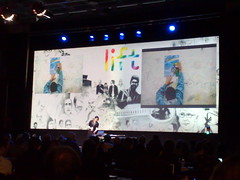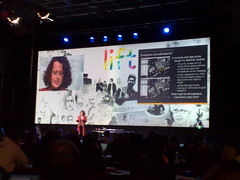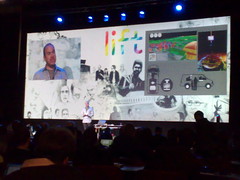LIFT 2008: User Experience
 First, Younghee Jung on Nokia "Open Studio: Vision by Relevance, Design for Use"
First, Younghee Jung on Nokia "Open Studio: Vision by Relevance, Design for Use"
Telecomms is older than a century. Mobile has been around long enough for us to stop asking what it is.
Photo of an Indian girl placing her mobile phone on the altar in her house. It's the only electronics in her house, she uses it to record TV and radio. What would you design for her? What information would you need to do this?
3.1bn out of the 6.5bn people worldwide used mobiles last year. New subscribers will come from Indonesia, China, Brazil: countries undergoing vast socioeconomic changes.
What do their researchers do? Close observation in daily life, and workshop/focus group style stuff.
Nokia Open Studio was a design competition, hosted in Mumbai, Rio and Accra (Ghana). A local team in each location, recruited from the community where possible, ran things. Teams came up with slogans for the competition, promoted it with slogans, T-Shirts (in Rio).
Challenges: weather (Mumbai had its rainy season and was flooded with rain and sewage), security (the neighbourhood in Rio was often considered off-limits for outsiders thanks to gang problems), electricity (scarce in Accra).
Process: an entry form (one sheet of A3 paper), handed to participants during a visit to the studio. Illiteracy in Mumbai meant the local team had to assist. An interview helped the team understand how entries related to the entrants personal situation (rather than just being a list of functions). Then a photo-shoot of the entrants with their entry.
Winner selection: local teams explained entries in the context of their local knowledge; an award ceremony where a token outsider presented the award. These were quite big in the local community - lots of entrants brought their families along. Feedback was that entrants felt proud, thanks to their being asked what they wanted.
Entries:
- "Cloud-buddy mobile": a phone which can be pointed at the sky to check the weather, to see whether it's going to rain or not. Lots of local folks argued that this was nothing new, but it pulled through because it was felt to be intuitive to use, was entered by a woman (rare in Mumbai) and met a real need: lack of information sources like TV or radio meant that weather forecasts were hard to come by for a normal housewife.
- "Eco-Cell", a phone to measure pollution locally which was solar charged. Voted unanimously the best by the Rio team. All three communities had self-built sewage system and big pollution problems.
- "Four-star", a phone which can host 4 SIM cards to allow a user to take advantage of pricing of the 4 local operators (who all offer free/cheap calls within network). SIM switching is common here. The designer also wanted the phone to be a playstation and play cable TV too :)
Distinctive aspects that emerged from the communities:
- Mumbai: one designer wanted a speaker on the phone so he could share announcements at religous festivals. Media sharing was a common theme. Heart-shaped phones were common too (symbolising the closeness of the mobile to the individuals heart). Symbolism of shape was clearly important. Also a bottle-shaped phone to store water for drinking, that would also float in water when it's dropped. Durable, unbreakable, waterproof: these were all themes. In this community phones are kept for a very long time, it's not unusual to see keypads completely worn off.
- Rio: a bossy 11-year-old daughter wants a phone to monitor her mother. With high teenage pregnancy rates here, many mothers leave their children at home to study.
- Accra: solar powered phone with translator (designers home town had no electricity - a charging station means owners have to pay to charge their phones). Shared usage of phones was noted; removable cameras were proposed to make it easier to share a phone between a few people (I didn't quite follow why). Visual caller ID was proposed to forge stronger relationship between a child and distant parents. Another caller wanted GPS caller ID to locate his future wife and ensure she is where she says she is. Many refugees were dependent on remote relatives sending them money - and proposed second screens to ensure they never missed a call.
Why did Nokia do this? Being in a corporate design team, they're subject to time constraints - what can they learn about an environment in, say, a 2-week visit? This is all about getting a better understanding of remote unfamiliar environments, by focusing on what local individuals wants as an ideal, instead of concentrating on the present.
Entries let Nokia see a very subjective view of technology expressed by participants. They may ask for participants to design devices other than phones in future.
 Next, Genevieve Bell, Director of User Experience at Intel: "Secrets, Liues and Digital Deceptions"
Next, Genevieve Bell, Director of User Experience at Intel: "Secrets, Liues and Digital Deceptions"
Intel has 30 anthropologists, helping orient Intel towards how people relate to their technology.
3 moments caught her attention this year:
- She locked herself out of her Flickr account by lying about her birthdate and place of birth inconsistently. She wondered who else has done this. Half of people with mobiles actively lie about where they are when texting.
- 100% of people using online dating sites lie about their height (men) and weight (women).
- James Katz: "we're entering an arms race of digital deception". For every device which purports to tell the truth (e.g. LBS) there's another to help us deceive (alibi services).
She did a fairly cheap and cheerful, global comparitive anthropological survey. Technology changes faster than people do - it hasn't transformed all of us as much as we'd like to believe. This is hard for Intel to wrap its head around.
So, secrets (knowledge we withhold) and lies (untruths).
Lying is inherently a bad thing, as we see from legal systems and religions around the world, e.g. sins of commission, sins of omission in Catholicism. In Islam, Mohammed identifies circumstances where witholding the whole truth can be positive (e.g. to keep the peace in the home). Similar proscriptions exist in Judaism. Tamil saying: "it's OK to tell a thousand lies if the wedding still happens".
Secrets are very different in different cultures: it's ambiguous. Sharing secrets generates trust. Some secrets are enshrined in concepts like national security.
Cultural practices are different to these ideals: we lie all the time (6-200 lies/day): from greasing social skids through concealing misbehaviour, increasing popularity. Men tell 20% more lies than women - women tell fewer, but better lies. Secrets on the other hand are broken and kept irrespective of religion or laws.
Some social theorists argue lying is a necessary part of daily life. It's not the opposite of truth, it's about negating the real around us. Self-deception is a part of survival, we actively repress the things we can't handle. Lies can be seen as a form of play, a way of working through identity and rules.
Freedom of information to everyone is a relatively recent notion and not one that's got much history in cultures. e.g. aboriginal cultures have an idea of secret knowledge for men and women. Witholding information keeps it "safe". What we choose to withold and why is part of a mechanism for keeping us safe.
Online we lie about location, context, intent, identity, etc. Some of this is necessary: there are many people on Myspace who are probably younger than 14. 10% of their population probably aren't over 100, as they claim: you have to lie if you're younger than 14, to get onto the service.
References postsecret.com
Mobiles have tracking services related to them. In Korea there are services that create digital alibis for you.
Early insights: there are interesting tensions between cultural ideals and practices. New technologies have the potential to tell the truth, unbidden. Is this what we want?
Do these twin ideas of secrets and lies give us new ways of thinking about privacy and security?
Shows a photo of a sign, pointing out that a road is 6 feet wide and not, as sat-nav suggests, a 2-lane highway. Devices lie too :)
Fantastic.
 Finally in this track: Paul Dourish, an AI researcher.
Finally in this track: Paul Dourish, an AI researcher.
When we think about ethnography as a way to understand things we should build, as a form of market research, we miss its grounding as an analytic process.
What's mobility, from the perspective of tech design? Location, localisation, mapping, coordinates, longitude, services.
From an ethnographic perspective, it'd be home, diaspora, pilgrimage, colony, asylum, migration, nomad. Drawing on this, a couple of pieces done by anthropologists (not by anyone working within tech companies or with any regard to technological interventions):
First, aboriginal navigation: presence or absence of people from a landscape. Places from which people are excluded or exclude themselves. Patterns of navigation can't be divorced from concerns like, who you are, in this context - e.g. you need to take into account sacred sites and the imprint of historical or mythic actions that have occurred there. Ritual exclusions stop mothers-in-law and sons-in-law from meeting, say: the presence of certain others stops you from being there. Sometimes you can only tell the significance of a space by the absence of others from it.
Second, Lisa Malkki of Stanford about Hutu refugees living in Tanzania, looking at how they thought of their identity as refugees. You might consider this as a negative identity, but refugee status was valued and projected as a sign of the refusal to become naturalised to a place where they didn't belong. Clinging to refugee status claims an ethnic identity distinct from geographical status.
Third, paroled sex offenders tagged by location and excluded from certain places by conditions of their parole. There's a series of resonances between their situation and the claims of Malkki around presence and location; and with the aboriginal study and the implications of absence from space. Sex offenders are unusual in that they have abrogatd their social rights to privacy.